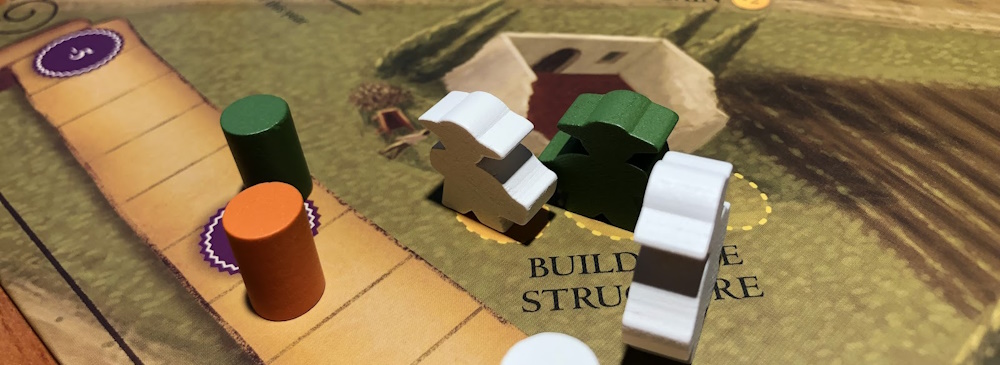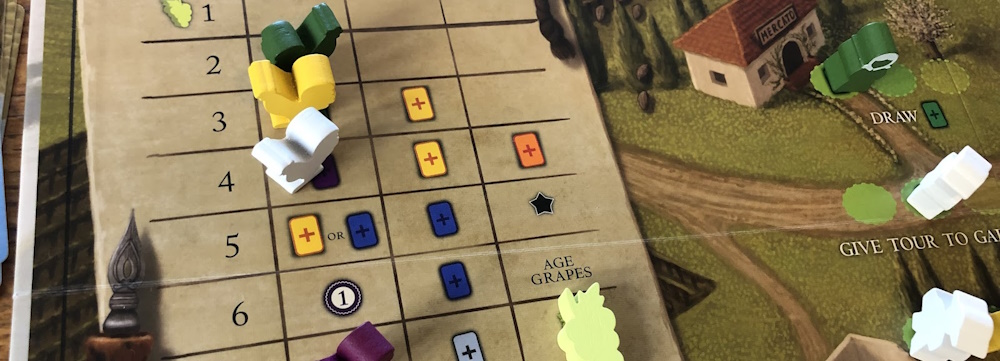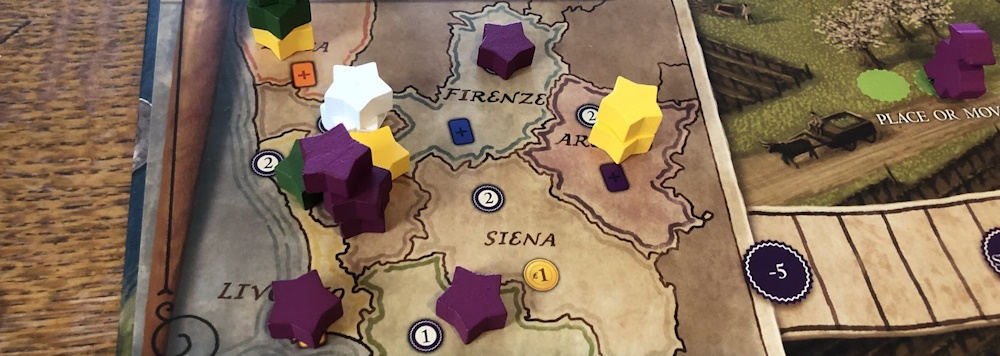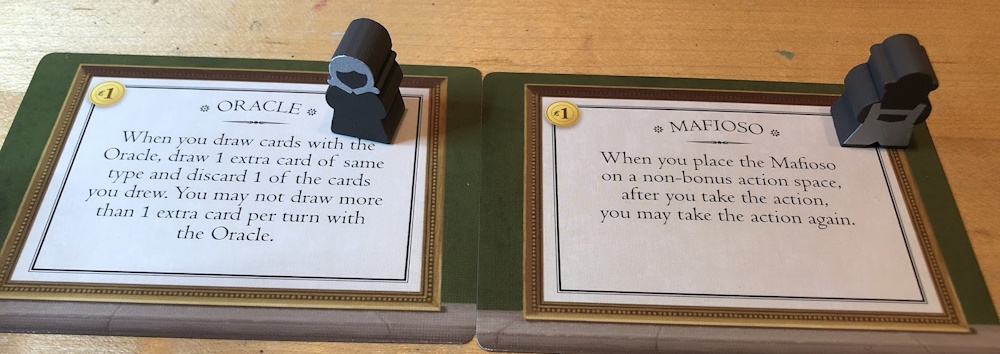Viticulture: Essential Edition and Tuscany Essential Edition
review by Luka
What is Viticulture: Essential Edition?
Viticulture: Essential Edition is a 1-6 player competitive worker placement game with engine building mechanics in which each player has inherited a vineyard in pre-modern Tuscany. Your goal is to have the most successful vineyard on the table by filling wine orders to score victory points; once a player scores 20 points, the game ends after the current year. Wine is made by placing workers to draw vine cards and plant vines in your vineyard in summer, and then harvest grapes and create wine in winter. To support this process, there are structures that players can build which provide passive effects, and there are summer and winter visitors which provide powerful benefits when you play them in the appropriate season.
If you only want to read about Viticulture: Tuscany Essential Edition Expansion, or the Tuscany Expansion as I’ll refer to it, scroll down.
Viticulture: Essential Edition Setup
To set up Viticulture: Essential Edition, each player gets their own vineyard mat with color-associated wooden game pieces; these pieces include 1 rooster-shaped wake-up token, 1 grande worker, 5 regular workers, 8 different structure tokens, 1 cylindrical victory point token, and 1 bottle-shaped residual payment tracker token per player. Additionally, 3 field cards are placed on the top section of each player’s vineyard, numbered 5, 6, and 7. These fields are where vine cards are planted.
 A vineyard mat during gameplay; this player has the trellis, irrigation, and medium cellar structures alongside 2 regular workers and a grande worker. Two vines are planted in the 5 value field and they have a 3 value grape in their crushing pads.
A vineyard mat during gameplay; this player has the trellis, irrigation, and medium cellar structures alongside 2 regular workers and a grande worker. Two vines are planted in the 5 value field and they have a 3 value grape in their crushing pads.
The main game board is then placed in between all players in a spot that is within reach of all of them. The vine, wine order, and summer and winter visitor cards are then shuffled and placed in their color-coded spaces on the main board. The gray worker token is placed next to spot 7 on the wake-up order chart. Then each player places their victory point token at 0 points and their residual payment tracker on the lira symbol, both located on the board.
 The main board mid-game with accompanying charcuterie to get in the mood for the theme.
The main board mid-game with accompanying charcuterie to get in the mood for the theme.
After, a red and a blue card are dealt out to each player. The cards represent who the player’s parents were and what they’ve left behind, thus forming the player’s starting resources. The red cards always give you 2 workers and an assortment of three cards. The blue cards give a grande worker, possibly some lira, and the choice between having a structure already constructed or some more lira. The optional structure and the starting workers are placed in their appropriate spot on the player’s vineyard mat while their unused game pieces and lira are kept close by. Their cards are kept secret in their hand.
 A red and blue card denoting starting resources for a player.
A red and blue card denoting starting resources for a player.
Optionally, each player can be dealt two red and two blue cards instead. In doing so, they are given the option to choose which one of each color they want to keep and have more agency over their starting conditions.
Lastly, the first player is chosen randomly and is given the first-player token.
Viticulture: Essential Edition Gameplay
Gameplay in Viticulture: Essential Edition takes place over the course of several rounds which represent and are called years in the game. Each year first starts in spring, where the player with the first-player token places their rooster-shaped wake-up token on a number on the wake-up chart. They then receive the bonus attributed to that number. This process is then repeated for all other players, going counter-clockwise around the table. However, each player can’t put their rooster on a number that already has a token on it. Once everyone has placed their rooster down, the year proceeds to summer.
 The wake-up chart.
The wake-up chart.
In summer, each player takes turns placing workers in summer action spaces or passing to the next season, starting with the player whose rooster is on the lowest-value number or at the top of the wake-up chart, and proceeding downwards before repeating with the top rooster player again.
A player who places a worker during their turn must be placed on an available space and immediately takes the action associated with that space. The grande worker, however, ignores the space restriction at any action and can be placed at an action with no spaces open. Passing to next season prevents you from placing any more workers for the current season, and any placed workers remain unavailable to use for future seasons.
 Here, the white player placed their grande worker at this summer action space since all spots were taken up by other workers in this 4 player game.
Here, the white player placed their grande worker at this summer action space since all spots were taken up by other workers in this 4 player game.
In summer, these actions include giving a tour to gain 2 lira, building a structure at the cost of lira, drawing a vine card, planting a vine card onto an available field on the player’s vineyard, and playing a summer visitor card. The more players there are, the more spaces there are available for each action; in a 2-player game, only one space is open at each action, while there are two for 3-4 players and 3 for 5-6 players. Additionally, with more players present, bonus spaces will open up at each action, giving additional benefits to the first player to place their worker on that spot.
 The bonus space on the give tour action grants the player an additional lira.
The bonus space on the give tour action grants the player an additional lira.
After summer, the players enter fall, in which they can draw either a summer or winter visitor card before transitioning into winter. Winter works much the same way summer does, except different actions become available. These actions include training a new worker for 4 lira, drawing a wine order card, harvesting a field, making up to two wine tokens, filling a wine order, and playing a winter visitor card.
A player harvesting a field involves adding up all the grape values of each grape type (red and white grapes) on one of their fields and placing a glass bead token onto each of the sum values on their board’s grape crushing pads. These grapes are then made into wine by taking the associated action and dragging the glass bead from the crushing pads, to the cellar over the appropriate wine color and value. Higher value wines and combination wines require upgraded cellars to store. The wines are then sold by filling wine orders. When a player fills a wine order, they reveal the associated wine order card from their hand, discard the beads that represent the wines they are selling, and then gain the victory points and increase their residual payments by the values specified before discarding the card.
 The purple wine order card demands there be at least a 6 and 7 value red wine in the player’s cellar to fill. These will require both the medium and large cellar structures to house. The reward is 5 victory points and 2 additional lira to the end of year residual payments.
The purple wine order card demands there be at least a 6 and 7 value red wine in the player’s cellar to fill. These will require both the medium and large cellar structures to house. The reward is 5 victory points and 2 additional lira to the end of year residual payments.
Once everyone is done with winter, the year ends. All grapes and wines age, increasing their values by one, each player grabs their workers and rooster tokens, players are then paid lira via their residuals, and the first-player token is passed to the left. With that, a new year starts.
 These grapes were harvested this turn from the first field, making a 3 value red grape and a 2 value white grape. At the end of the year, their values will each increase by one, represented via the glass bead token shifting over to the next number.
These grapes were harvested this turn from the first field, making a 3 value red grape and a 2 value white grape. At the end of the year, their values will each increase by one, represented via the glass bead token shifting over to the next number.
What does the Tuscany Expansion add?
The Tuscany Expansion adds three modules: a new main game board, special workers, and a vineyard mat extension for playing with new orange structure cards.
The new game board increases the victory points needed to end the game to 25, and makes each season more interesting now that every season, not only summer and winter, has action spaces to place workers.
 Tuscany board with green spring spaces, yellow summer spaces, orange fall spaces, and blue winter spaces.
Tuscany board with green spring spaces, yellow summer spaces, orange fall spaces, and blue winter spaces.
The multiple seasons are made even more important through the wake-up chart overhaul: in spring, players still put their roosters down as normal, but now you do not get any bonuses until you move into the next season. For each season, there may or may not be a wake-up chart bonus depending on your position. Furthermore, the only way to get to the top spot is by going last the previous year.
 New wake-up chart with all players in summer.
New wake-up chart with all players in summer.
There’s also a new “influence” mechanic where players place stars on a map of Tuscany regions to get immediate bonuses and score more points at the end of the game for having the most stars on a region.
 Tuscany board map with stars in regions.
Tuscany board map with stars in regions.
The special workers module introduces 2 new game pieces per color which are used to represent the special workers. These workers are determined at the start of the game by shuffling and drawing two special worker cards from the eleven available. The two cards denote what each worker’s unique abilities are, such as the Mafioso, which allows the player to take an action twice if he’s placed on a non-bonus space.
 2 special worker cards with new game pieces.
2 special worker cards with new game pieces.
Lastly, the vineyard mat extension gives players the opportunity to build a wider variety of structures represented by cards. Players score a victory point upon building one of these structures which have either residual bonuses, enhancement effects which are passive, or actions that can be taken with a worker.
 Vineyard mat with structure extension.
Vineyard mat with structure extension.
 Structure deck and discard.
Structure deck and discard.
Final Review
Viticulture: Essential Edition was my first worker placement game I ever played, serving as a fantastic introduction to the genre! Splitting a year into two seasons where you place workers makes it so you are still rewarded for planning ahead without overwhelming you with having to plan too far ahead. Additionally, there’s a satisfying progression as you go from planting, to harvesting, to making wines and selling them which all other mechanics help push. Once these steps are clear, it becomes easy to form a plan of action. Yet at the same time, the other players’ placement of workers can limit what you can do, while the variance of your starting resources and the cards drawn adds further interest which encourages you to adapt. For example, you may have wanted to draw some order cards this year, yet the spaces are full. So instead, you must change your plans and decide to harvest your fields this winter. The aging of grapes at the end of each year therefore provides an avenue to prepare higher value wines for orders you will draw in the future.
However, for all the positives that variance through randomness offers in replayability, it can be a “feels-bad” at times. Sometimes, you are just unlucky in the wine order cards you draw, making it very difficult to get residuals and score early on. And not all visitor cards are made equally: some visitors have incredibly powerful effects, while others are more inhibited. As a positive result, though, it makes drawing cards to be an incredibly powerful effect.
The Tuscany Expansion adds onto the base game experience a lot. The new game board offers new avenues to accomplish the same gameplay goals through new action spaces spread across four seasons instead of two. For example, you could draw order cards in fall, or you could draw them in spring through the place star action space and having the influence star placed on the Arezzo region on the map. Or you can use the trade action space to trade 1 grape for 2 cards of any type, including wine order cards. Additionally, if you need victory points now, but you don’t have an order you can fill, you can choose to sell wine tokens in winter for victory points outright with the sell one wine token action space.
The special worker module further rewards opportunistic and clever planning to either compound the benefits when placing them or limit your opponents' options through careful worker placement. And lastly the structure cards offer powerful effects that give you more ways to spend your lira outside the standard structures. I find that a little over midway through the game, I run out of things to spend lira on; I have all the workers and basic structures I need. But with the structure cards, I have more ways to get victory points and resources in the late game through my lira.
To conclude, Viticulture: Essential Edition makes a great introduction to the worker placement genre while also offering enough of a learning curve, variance, and strategy to keep experienced players interested. The Tuscany Essential Edition Expansion further builds on the game’s mechanics to add more factors to plan for and interact with. I’d especially recommend this game to friends or families who enjoy playing board games together and want to expand their game library into worker placement games. I’d also recommend this game to any wine connoisseurs with a penchant for gaming! The Tuscany Expansion is definitely recommended if you enjoy the base game as it only improves the experience!
Viticulture: Essential Edition and the Tuscany Essential Edition Expansion are available from our webstore now.
